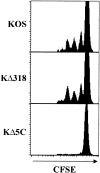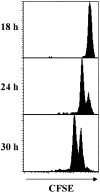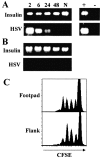Rapid cytotoxic T lymphocyte activation occurs in the draining lymph nodes after cutaneous herpes simplex virus infection as a result of early antigen presentation and not the presence of virus
- PMID: 11877488
- PMCID: PMC2193766
- DOI: 10.1084/jem.20012023
Rapid cytotoxic T lymphocyte activation occurs in the draining lymph nodes after cutaneous herpes simplex virus infection as a result of early antigen presentation and not the presence of virus
Abstract
Localized cutaneous herpes simplex virus type 1 (HSV-1) infection leads to arming and initial expansion of cytotoxic T lymphocytes (CTLs) in the draining popliteal lymph nodes (PLNs) followed by migration and further proliferation in the spleen. To accurately characterize the sequence of events involved in the activation and generation of anti-HSV CTLs, we used T cell receptor (TCR) transgenic mice specific for the immunodominant epitope from HSV glycoprotein B (gB(498-505)). We describe the detection of the initiation of antigen presentation in the draining lymph nodes by 4-6 h after infection with HSV-1. Analysis of CD69 up-regulation revealed activation of gB-specific CD8(+) T cells by 6-8 h after infection. Furthermore, we show that T cell proliferation begins no sooner than 24 h after activation and is marked by the concurrent appearance of CTL activity in the PLNs. These events are not dependent on the presence of virus in the draining lymph nodes, and suggest a requirement for recruitment of professional antigen-presenting cells to the site of T cell activation. Consequently, we have defined the initiation of the CD8(+) T cell-mediated response to cutaneous HSV-1 infection, demonstrating that the immune response to localized viral infection depends only on the appearance of cells presenting virus-derived antigen and commences with remarkable swiftness.
Figures





Similar articles
-
Progression of armed CTL from draining lymph node to spleen shortly after localized infection with herpes simplex virus 1.J Immunol. 2002 Jan 15;168(2):834-8. doi: 10.4049/jimmunol.168.2.834. J Immunol. 2002. PMID: 11777979
-
Herpes simplex virus type 1-specific cytotoxic T-lymphocyte arming occurs within lymph nodes draining the site of cutaneous infection.J Virol. 2000 Mar;74(5):2414-9. doi: 10.1128/jvi.74.5.2414-2419.2000. J Virol. 2000. PMID: 10666272 Free PMC article.
-
Diminished secondary CTL response in draining lymph nodes on cutaneous challenge with herpes simplex virus.J Gen Virol. 2000 Feb;81(Pt 2):407-14. doi: 10.1099/0022-1317-81-2-407. J Gen Virol. 2000. PMID: 10644839
-
Skin-associated lymphoid tissue in human immunodeficiency virus-1, human papillomavirus, and herpes simplex virus infections.J Invest Dermatol. 1995 Jul;105(1 Suppl):99S-104S. doi: 10.1111/1523-1747.ep12316241. J Invest Dermatol. 1995. PMID: 7616007 Review.
-
Stress-induced neuroendocrine modulation of viral pathogenesis and immunity.Ann N Y Acad Sci. 1998 May 1;840:803-8. doi: 10.1111/j.1749-6632.1998.tb09618.x. Ann N Y Acad Sci. 1998. PMID: 9629306 Free PMC article. Review.
Cited by
-
Us3 kinase encoded by herpes simplex virus 1 mediates downregulation of cell surface major histocompatibility complex class I and evasion of CD8+ T cells.PLoS One. 2013 Aug 12;8(8):e72050. doi: 10.1371/journal.pone.0072050. eCollection 2013. PLoS One. 2013. PMID: 23951282 Free PMC article.
-
Virus-induced tumor inflammation facilitates effective DC cancer immunotherapy in a Treg-dependent manner in mice.J Clin Invest. 2011 Jul;121(7):2570-82. doi: 10.1172/JCI45585. Epub 2011 Jun 6. J Clin Invest. 2011. PMID: 21646722 Free PMC article.
-
Herpes simplex virus-specific memory CD8+ T cells are selectively activated and retained in latently infected sensory ganglia.Immunity. 2003 May;18(5):593-603. doi: 10.1016/s1074-7613(03)00112-2. Immunity. 2003. PMID: 12753737 Free PMC article.
-
Developments in herpes simplex virus vaccines: old problems and new challenges.Folia Microbiol (Praha). 2006;51(2):67-85. doi: 10.1007/BF02932160. Folia Microbiol (Praha). 2006. PMID: 16821715 Review.
-
Home sweet home: How do virus specific T cells navigate to the skin?J Clin Invest. 2002 Aug;110(4):441-2. doi: 10.1172/JCI16516. J Clin Invest. 2002. PMID: 12189237 Free PMC article. No abstract available.
References
-
- Banchereau, J., and R.M. Steinman. 1998. Dendritic cells and the control of immunity. Nature. 392:245–252. - PubMed
-
- Cose, S.C., C.M. Jones, M.E. Wallace, W.R. Heath, and F.R. Carbone. 1997. Antigen-specific CD8+ T cell subset distribution in lymph nodes draining the site of herpes simplex virus infection. Eur. J. Immunol. 27:2310–2316. - PubMed
-
- McNally, J.M., D. Dempsey, R.M. Wolcott, R. Chervenak, and S.R. Jennings. 1999. Phenotypic identification of antigen-dependent and antigen-independent CD8 CTL precursors in the draining lymph node during acute cutaneous herpes simplex virus type 1 infection. J. Immunol. 163:675–681. - PubMed
-
- Coles, R.M., S.N. Mueller, W.R. Heath, F.R. Carbone, and A.G. Brooks. 2002. Progression of armed CTL from draining lymph node to spleen shortly after localised infection with HSV-1. J. Immunol. 168:834–838. - PubMed
Publication types
MeSH terms
Substances
Grants and funding
LinkOut - more resources
Full Text Sources
Other Literature Sources
Medical
Molecular Biology Databases
Research Materials

